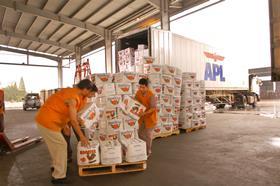
California regained official access to the Chinese market in August following a 14-month hiatus, and the trade is bullish about sales, which are resuming this month as the new season gets underway.
“California citrus – with short transit times, no requirement for cold treatment, good quality and lower prices than competitors such as Australia –has always been one of the major imported items,” said Kurt Huang of Shanghai Huizhan Fruit and Vegetable Wholesale Market.
Nevertheless, he expects the early part of the season could be somewhat challenging –in line with historical trends.
“The major problem is the domestic oranges, which have higher brix levels and are very, very cheap,” he said. “So it’s difficult in the early period. But later after the domestic season has peaked, it will become much easier.”
Driving up volumes this year is likely to be the arrival of new importers into the business. “The fruit business in China is very easy to enter, it doesn’t require a lot of capital, all the import procedures are handled by professional service providers, so the competition is becoming very intense,” Huang explained.
While California citrus lost official access for more than a year, Huang does not believe it will impact on its market position or share in China.
“Sunkist is such a well-known brand among consumers, and even with the absence of California-grown Sunkist, it was still promoted by Australian and South African growers,” he said.
Rather it is competing Northern Hemisphere citrus exporters, who took advantage of California’s lack of access last year, that are most likely to be affected this season. “They’re the ones who need to worry,” he noted. “They entered the Chinese market on the back of the absence of US citrus. They might not have such a good chance in the Chinese market again.”
California citrus was suddenly barred from the Chinese mainland last April due to discoveries of phytophthora rot in some shipments of California citrus. New protocols now in place for mitigating phytophthora incidence are apparently sufficient to satisfy Chinese quarantine officials.
According to the FAS, China imported nearly 45,000 tonnes of oranges during 2012 (September-August) and 38,600 tonnes in 2013; however, imports dropped to just 13,500 tonnes for the same period last year.
“China re-opening its market has to be a positive for the industry,” said Dan Kass of Paramount Citrus. “It’s a major market and an important one in keeping export distribution balanced across the region.”
Despite a crippling drought, California citrus growers appear on course to produce a relatively normal crop of navel oranges for 2014/15.
According to the California Department of Food and Agriculture (CDFA) pre-season estimate, the state’s citrus industry is expected to produce 81m 18.1kg-carton equivalents of navels with 78m cartons coming from the San Joaquin – on a par with last year’s final packout. Considering that navel production in the San Joaquin has averaged 82.6m cartons over the last ten years, the coming season appears to be a fairly typical one.
“This crop is likely to come in short of the (CDFA’s) estimate,” said Al Imbimbo of Suntreat Packing & Shipping. “The trees have been under a lot of duress coming into the season from both the drought and last winter’s freeze.”
Smaller but tastier
Another factor that could impact carton yields directly related to drought is fruit diameter, which according to the CDFA is measuring one of the smallest in several seasons.
“The size curve is definitely smaller than last year,” said Tom Wollenman of LoBue Brothers. “One reason is that we had an extremely hot summer, stunting fruit growth, and well pressures are down with the falling water table, so orchards received less daily irrigation than they would have.”
According to most industry observers, the California navel crop will likely peak on count 88, followed by 72s and then 113s. Without substantial precipitation over the next several months, however, many believe that 113s could be the second-most prevalent size packed this season.
Despite the smaller size curve, the 2014/15 navel crop apparently is not short on taste.
“We had a very warm summer, which has brought on fruit sugars, so we’ve got some of the most flavourful fruit I’ve seen in years,” said Imbimbo. “Fruit appearance is quite good as well.”
“There’s not nearly the wind scarring this year in Kern County compared to last season,” says Wollenman. “The summer heat also toughened the rind so I’m expecting the fruit to ship well. All things considered, the industry should have a very decent piece of fruit to offer markets both domestic and export.”
Read the upcoming November issue of Asiafruit for a full preview of the California citrus season. Order your copy from subscriptions@fruitnet.com



